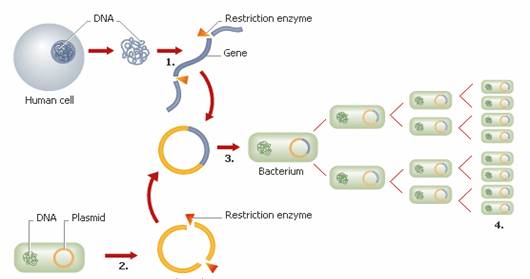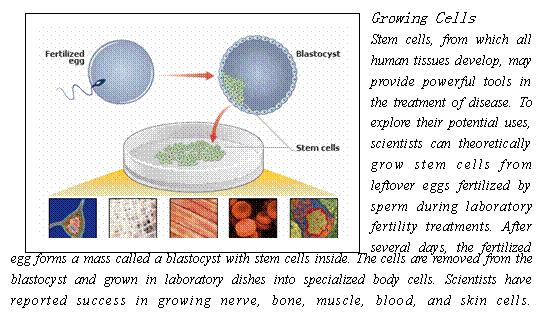Cloning
1. Introduction
Cloning, creating a copy of living matter, such as a cell or organism. The copies produced through cloning have identical genetic makeup and are known as clones. Many organisms in nature reproduce by cloning. Scientists use cloning techniques in the laboratory to create copies of cells or organisms with valuable traits. Their work aims to find practical applications for cloning that will produce advances in medicine, biological research, and industry.

Genetic Engineering
Genetic engineering enables scientists to produce clones of cells or organisms that contain the same genes. 1. Scientists use restriction enzymes to isolate a segment of deoxyribonucleic acid (DNA) that contains a gene of interest—for example, the gene regulating insulin production. 2. A plasmid removed from a bacterium and treated with the same restriction enzyme binds with the DNA fragment to form a hybrid plasma. 3. The hybrid plasmid is re-inserted back into the bacterium, where it replicates as part of the cell's DNA. 4. A large number of identical daughter cells (clones) can be cultured and their gene products extracted for human use.
2.Overview
Farmers started cloning plants thousands of years ago in simple ways, such as taking a cutting of a plant and letting it root to make another plant. Early farmers also devised breeding techniques to reproduce plants with such characteristics as faster growth, larger seeds, or sweeter fruits. They combined these breeding techniques with cloning to produce many plants with desired traits. These early forms of cloning and breeding were slow and sometimes unpredictable. By the late 20th century scientists developed genetic engineering, in which they manipulate deoxyribonucleic acid (DNA), the genetic material of living things, to more precisely modify a plant's genes. Scientists combine genetic engineering with cloning to quickly and inexpensively produce thousands of plants with a desired characteristic.
Cloning techniques can also be applied to animals. Scientists generate genetically modified animals with new traits, such as the ability to resist disease, and they use cloning techniques to reproduce these genetically modified animals. In the near future scientists hope to bolster populations of endangered species by cloning members from existing populations. Someday scientists may even resurrect extinct species by cloning cells from preserved specimens.
Industry also utilizes cloning technology. For example, some bacteria eat toxic substances, such as gasoline or industrial chemicals, that are common pollutants. These bacteria can be cloned to make legions of bacteria with the ability to clean up environmental contamination (see Bioremediation). Likewise, cloned animals can be used to make a variety of ingredients, such as proteins, that are used in many commercial products.
Perhaps most important from a human perspective, cloning promises great advances in medicine. Scientists have already inserted fragments of DNA containing the human gene for a blood-clotting protein into cells of a sheep. Through cloning techniques, scientists have generated new sheep whose milk contains the protein, which is needed by people with the blood-clotting disorder known as hemophilia. In the near future, researchers hope to use cloning to develop animals with human diseases and use these cloned animals to test the safety and effectiveness of new treatments devised for humans. Biomedical scientists hope to take cells from an ill patient, genetically modify them, and clone the modified cells to grow exactly the cells that the patient needs to regain health. Some scientists even imagine a day when cloning could be part of a process that grows entire organs for transplants.
Despite the current and potential benefits of cloning, the process fuels a fiery battle. Little controversy ever surrounded plant cloning. In fact, few people even think of making plants from cuttings as cloning at all, but it is. Many people fight against the creation and cloning of genetically modified plants. But that worry generally involves the manipulation of the plant's DNA, not the cloning process.
Animal cloning, on the other hand, stirs heartfelt controversy. Critics argue that the science of cloning is in its infancy and, in order to achieve success, mistakes may be made along the way. This could result in the development of cloned animals or humans with serious defects. Opponents to human cloning argue that without proper regulation, cloning could result in such questionable practices as designing babies with chosen genetic qualities so that they are more athletic, beautiful, or intelligent. Others fear that cloning tampers with God's will. As a result of so much controversy, the future of cloning remains uncertain.

Microsoft Encarta 2006 Microsoft Corporation